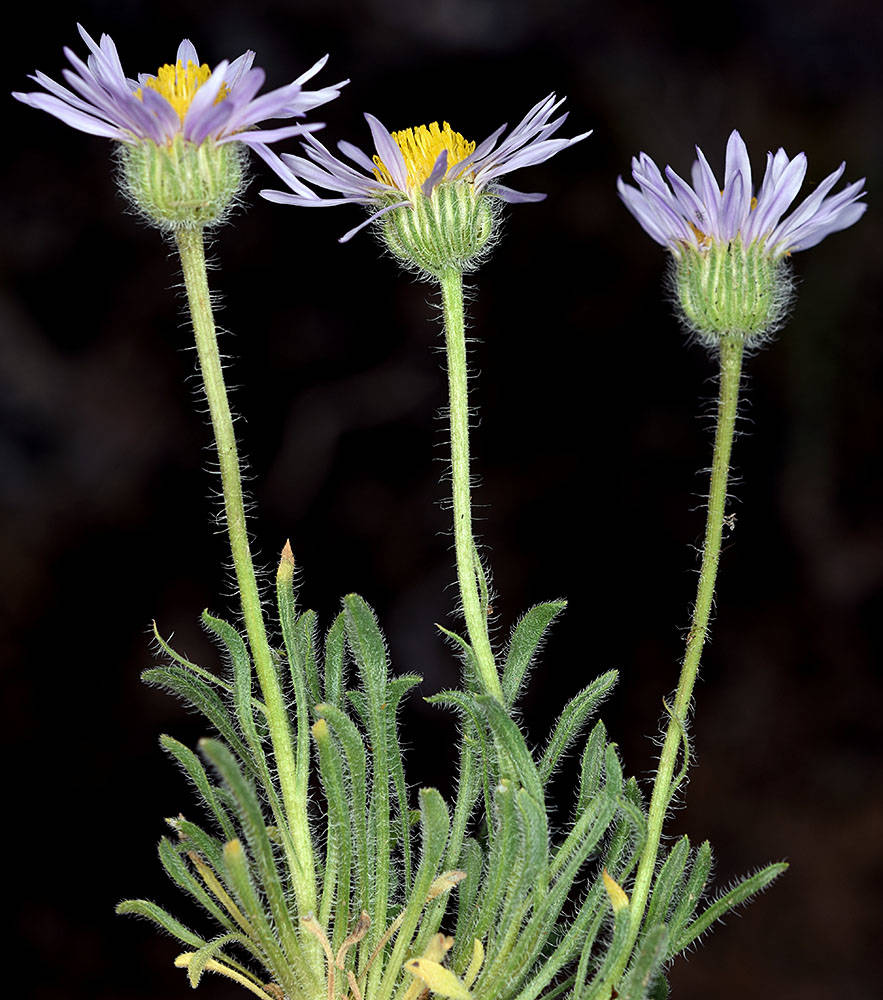
Plants perennial, 5–10 cm; taprooted, caudices branching.
Stems erect, sparsely to moderately hirsute, densely minutely glandular.
Basal leaves persistent, narrowly oblanceolate to spatulate, 15–50 × 1.3–4.5 mm, margins entire, tips rounded to acute or acuminate, surfaces moderately to densely hirsute to nearly hispid, minutely glandular.
Cauline leaves few, similar to basal, usually abruptly reduced distally.
Heads 1, radiate.
Involucres 6–9 × 13–21 mm.
Phyllaries in 2–3 series, with dark medial area, sometimes with orange stripe, surfaces sparsely to moderately hispid-hirsute, densely minutely glandular.
Ray florets 20–35, lavender to purple; rays 6–11 × 1–2 mm.
Disc florets 4–5 mm.
Fruits 2–4 mm, glabrate to sparsely strigose; inner pappi of numerous barbellate bristles.
Open areas, sagebrush, streambanks. Flowering May–Jul. 1600–2000 m. Owy. ID, NV. Native.
Erigeron latus and E. poliospermus are very similar with the exception of the vestiture of the fruits. Further research is needed to determine if continued recognition of two distinct species is warranted.
as described under Erigeron latus
Perennials, 3-8 cm; taprooted, caudices branched. Stems erect, sparsely hirsuto-villous (hairs equal), densely minutely glandular. Leaves mostly basal (persistent; petioles prominently ciliate, hairs spreading, thick-based); blades oblanceolate-spatulate to oblanceolate, 30-60 × 3-6 mm, cauline usually abruptly reduced distally, margins entire, coarsely ciliate, faces hirsute to hirsuto-villous, densely minutely glandular. Heads 1. Involucres 8-10 × 10-20 mm wide. Phyllaries in 2-3 series, sparsely hirsuto-villous, densely minutely glandular. Ray florets 15-25; corollas pinkish to purple, 7-10 mm, laminae coiling. Disc corollas 4.5-6 mm. Cypselae 3.5-4.5 mm, 2(-3)-nerved, faces sparsely strigose to glabrate; pappi: outer sometimes of setae, sometimes 0, inner of 20-27 bristles.Flowering May-Jul(-Aug). Flat to gently sloping, open sites with shallow, gravelly soils over bedrock, volcanic sands and cinder, often with sagebrush or sagebrush-juniper, rhyolitic riparian areas; 1400-2200 m; Idaho, Nev.